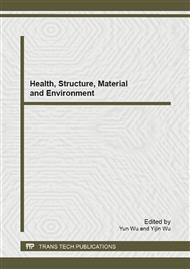[1]
YANG Shaowei, YANG Yingzi, DENG Hongwei, BA Hengjing. Early demage degree of construction in minus temperature concrete[J]. Concrete. 2004, (7): 12-15.
Google Scholar
[2]
YANG Yingzi, BA Hengjing. Interface microstructure and mechanical properties of concrete with antifreezing admixture at subzero temperatures[J]. Journal of the Chinese Ceramic Society. 2007, 35(8): 1125-1130.
Google Scholar
[3]
BA Hengjing, LI Zhonghua, ZHAO Yading. Study on early- age frozen- heave stress and the compressive strength rule of the concrete at subzero temperature[J]. Concrete. 2007, (10): 1-3.
Google Scholar
[4]
ZHU Weizhong, WANG Jian, NIU Changren. A view of application about elastic model method for frost damage of minus-temperature concrete[J]. Low Temperature Architecture Technology. 2001, (1): 9-12.
Google Scholar
[5]
LIU Xiaobo, LI Jiahe, ZHU Weizhong, ZHU Guangxiang. Research on critical strength of frozen injury in cacium-enriched fly ash concrete[J]. Low Temperature Architecture Technology. 2007, (5): 13-15.
Google Scholar
[6]
SU Xiaoning, WANG Xuan, CHI Daocai. Experimental research about the early age frost of concrete[J]. Concrete. 2005, (6): 87-89.
Google Scholar
[7]
Metin Husem, Serhat Gozutok. The effects of lowtemperature curing on the compressive strength of ordinary and high performance concrete[J]. Construction and Building Materials. 2005, 19(2): 49-53.
DOI: 10.1016/j.conbuildmat.2004.04.033
Google Scholar
[8]
GUO Baolin, YU Changhe, HAN Yu, ZHU Jupeng. Long-Term Performance of Concrete Suffered Infant Age Freezing[J]. Applied Mechanics and Materials. 2012, 174-177(5): 524-529.
DOI: 10.4028/www.scientific.net/amm.174-177.524
Google Scholar
[9]
M. Sofi, P.A. Mendis, D. Baweja. Estimating early-age in situ strength development of concrete slabs[J]. Construction and Building Materials. 2012, 29(4): 659-666.
DOI: 10.1016/j.conbuildmat.2011.10.019
Google Scholar
[10]
QU Feng, NIU Ditao. Effect of Freeze-Thaw on the Concrete Pore Structure Features[J]. Advanced Materials Research. 2011, 368-373(10): 361-364.
DOI: 10.4028/www.scientific.net/amr.368-373.361
Google Scholar
[11]
LI Yue, BAO Junling, SUI Chune, DU Xiuli. The Relationship between the Strength and the Pore Structures of Cement Paste with Mineral Admixtures[J]. Advanced Materials Research. 2011, 250-253(5): 104-108.
DOI: 10.4028/www.scientific.net/amr.250-253.104
Google Scholar
[12]
S.H. Oh, S.W. Kim, M.H. Ahn, Chang Kuk You, Hong In Shin, Suk Young Kim. Effects of Additives on Pore Structures in Freeze Dried Calcium Phosphate Granules[J]. Key Engineering Materials. 2003, 240-242(5): 493-496.
DOI: 10.4028/www.scientific.net/kem.240-242.493
Google Scholar
[13]
Rakesh Kumar, B Bhattacharjee. Porosity, pore size distribution and in situ strength of concrete[J]. Cement and Concrete Research. 2003, 33(1): 155-164.
DOI: 10.1016/s0008-8846(02)00942-0
Google Scholar
[14]
Omkar Deo, Narayanan Neithalath. Compressive behavior of pervious concretes and a quantification of the influence of random pore structure features[J]. Materials Science and Engineering. 2010, 528(11): 402-412.
DOI: 10.1016/j.msea.2010.09.024
Google Scholar
[15]
C.S. Poon, S.C. Kou, L. Lam. Compressive strength, chloride diffusivity and pore structure of high performance metakaolin and silica fume concrete[J]. Construction and Building Materials. 2006, 20(12): 858-865.
DOI: 10.1016/j.conbuildmat.2005.07.001
Google Scholar


